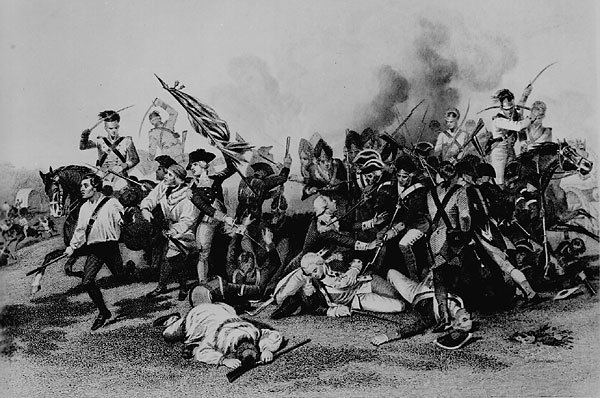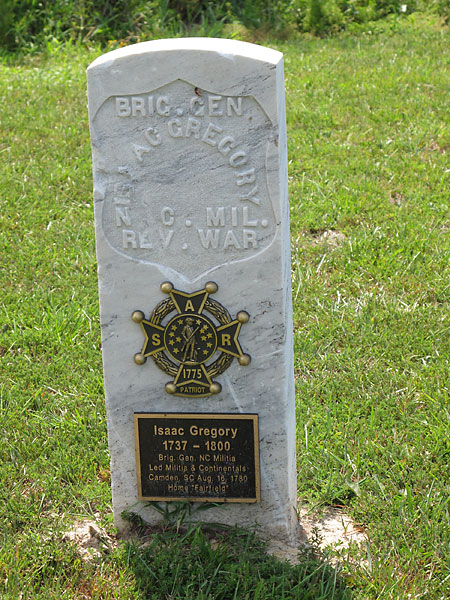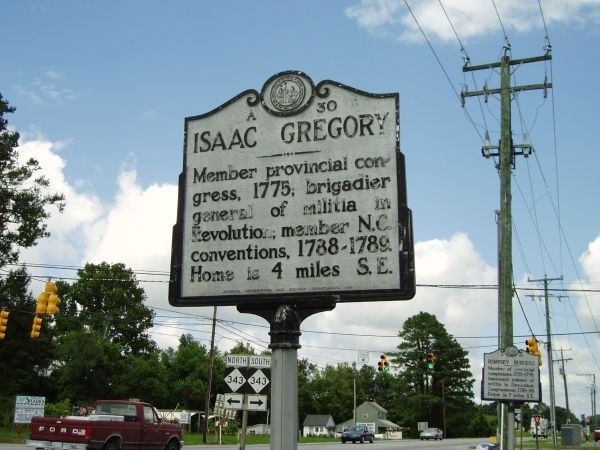Brigadier General Isaac Gregory
“To Camden folk, Isaac Gregory is the most dignified figure who has played a part in their history—partly because of the somewhat impressive surroundings into which he was born, but more largely because of his own rather austere bearing. The lighter touch at least was not one of his immediately apparent characteristics. And if his painstaking habits and ponderous actions tended to add to the impressiveness of his personality, by the same token they also helped to make of him a controversial individual. His deliberation, for example, could at times be a source of exasperation to his associates.”
A Camden County Hero

Across the road from a cornfield stands a small monument to Gen. Isaac Gregory. Inscribed are the dates of his birth and death: 1737 and 1800.
It says nothing, though, about his bayonet charge into the British troops of Lord Charles Cornwallis, that he was nearly killed or later falsely accused of treason based on an enemy prank.
At the Battle of Camden, SC, on April 16, 1780, General Isaac Gregory and his North Carolina militia stood against a charge of superior British forces while other militia ran. (Courtesy of National Archives)
Daughters of the American Revolution first set the marker some 100 years ago in front of the Gregory home. It was knocked down in the 1970s and forgotten.
But Gregory's descendants and others know of Gregory's heroics. They will honor the general who years ago led his inexperienced North Carolina militia into brutal hand-to-hand combat with some of the best-trained troops in the world.

Gregory was born in Pasquotank County, where he served as a sheriff, a militia colonel and a representative in the last General Assembly to meet under a royal governor.
In 1777, Pasquotank County was divided at the river forming the new county of Camden and included Gregory's home and property. He was appointed to a committee that established the courthouse in the new county. After the war, he represented Camden in the state's House of Commons and in its Senate.
"He was the most notable person to have ever lived in Camden County," said local historian Alex Leary.
On Aug. 16, 1780, a 43-year-old Gregory led a North Carolina militia at the Battle of Camden, S.C., under the overall command of Gen. Horatio Gates, the hero of Saratoga, according to several accounts, including the Encyclopedia of the American Revolution and the North Carolina Office of Archives and History.
Commanded by Lord Charles Cornwallis, the British forces charged the Americans, causing many of the militia units to flee. Gates fled with them and was later blamed for the resounding defeat where about 900 Americans were killed or wounded and 1,000 captured.
Despite the loss, there were acts of bravery by the Americans, in particular those of Gregory.
At the battle's worst, Gregory's men joined a charge with Continental regiments from Maryland and Delaware into the oncoming British. Gregory's horse was killed, pinning him to the ground. British soldiers bayoneted him twice as he lay there. He was captured, but British doctors released him when they thought he was dying. Cornwallis even recorded him as among the American dead.
Gregory recovered to lead a militia to protect northeastern North Carolina from a possible invasion of the British from Suffolk, according to the Dictionary of North Carolina Biography.
The British did make forays into the region. On one occasion, a British officer left behind a note as a prank saying Gregory was a traitor and may betray American troops. American forces found the note and Gregory was charged with treason.
The British officer heard about the charges and sent a letter explaining his prank. The case never went to court, but Gregory was hurt by the lack of trust in him.
"He never forgot that," Leary said.
After the war, Gregory ran a plantation called Fairfield where he built a 3-story brick mansion and had a family of six children. He died at the home and was buried there in 1800 at the age of 63. There is no sign of his grave.
The brick home was occupied until about the 1950s and stood for 30 more years until its remnants were torn down into a pile of bricks, said Bess Tillitt Godfrey Sawyer, a descendant of Gregory and owner of much of what was Gregory's plantation. Most of the brick rubble is gone now, too. The only sign is a patch of trees in the middle of a corn field.

The marker also has a story.
The Daughters of the American Revolution set the white 3-foot tall marker some 100 years ago in front of the Gregory home. It was knocked down in the 1970s and lay there until it disappeared for a while before being recovered.
For more than 30 years it stood in a corner of Sawyer's garage. In the spring of 2011, the Sons of the American Revolution had the marker cleaned and a new metal plaque mounted on it with the years of Gregory's birth and death and a note about the Camden battle on it. The marker was reset in a mowed area across from the cornfield where it once sat.
By Jeff Hampton
The Virginian-Pilot
August 14, 2011 CAMDEN COUNTY, N.C.
